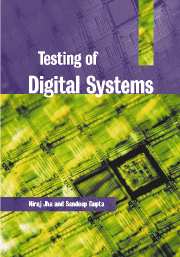Book contents
- Frontmatter
- Contents
- Preface
- List of gate symbols
- 1 Introduction
- 2 Fault models
- 3 Combinational logic and fault simulation
- 4 Test generation for combinational circuits
- 5 Sequential ATPG
- 6 IDDQ testing
- 7 Functional testing
- 8 Delay fault testing
- 9 CMOS testing
- 10 Fault diagnosis
- 11 Design for testability
- 12 Built-in self-test
- 13 Synthesis for testability
- 14 Memory testing
- 15 High-level test synthesis
- 16 System-on-a-chip test synthesis
- Index
3 - Combinational logic and fault simulation
Published online by Cambridge University Press: 05 June 2012
- Frontmatter
- Contents
- Preface
- List of gate symbols
- 1 Introduction
- 2 Fault models
- 3 Combinational logic and fault simulation
- 4 Test generation for combinational circuits
- 5 Sequential ATPG
- 6 IDDQ testing
- 7 Functional testing
- 8 Delay fault testing
- 9 CMOS testing
- 10 Fault diagnosis
- 11 Design for testability
- 12 Built-in self-test
- 13 Synthesis for testability
- 14 Memory testing
- 15 High-level test synthesis
- 16 System-on-a-chip test synthesis
- Index
Summary
In this chapter, we discuss logic and fault simulation methods for combinational circuits.
We begin by defining what constitutes a test for a fault and defining the main objectives of fault simulation algorithms. We then define some basic concepts and describe the notation used to represent the behavior of fault-free as well as faulty versions of a circuit.
We then describe logic simulation algorithms, including event-driven and parallel algorithms.
Next, we present a simple fault simulation algorithm and some basic procedures used by most fault simulation algorithms to decrease their average run-time complexity. This is followed by a description of the five fault simulation paradigms: parallel fault, parallel-pattern single-fault, deductive, concurrent, and critical path tracing.
Finally, we present some low complexity approaches for obtaining an approximate value of fault coverage for a given set of vectors.
Introduction
The objectives of fault simulation include (i) determination of the quality of given tests, and (ii) generation of information required for fault diagnosis (i.e., location of faults in a chip). In this chapter, we describe fault simulation techniques for combinational circuits. While most practical circuits are sequential, they often incorporate the fullscan design-for-testability (DFT) feature (see Chapter 11). The use of full-scan enables test development and evaluation using only the combinational parts of a sequential circuit, obtained by removing all flip-flops and considering all inputs and outputs of each combinational logic block as primary inputs and outputs, respectively.
- Type
- Chapter
- Information
- Testing of Digital Systems , pp. 49 - 133Publisher: Cambridge University PressPrint publication year: 2003
- 1
- Cited by



